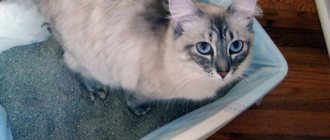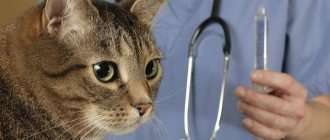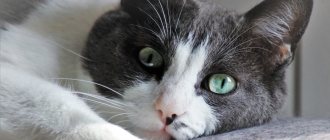9910Administration
If your cat occasionally has loose stools, there is little cause for concern. Diarrhea can be caused by any errors in food or the wrong combination of foods consumed together. However, when a cat has diarrhea with blood, vomiting, and a fever, this indicates not only poisoning, but also serious chronic diseases. Without special education, you won’t be able to cure your pet on your own, and you can’t waste time with such diarrhea. Therefore, at the first sign of bloody diarrhea, immediately contact a veterinary clinic.
Features of the disease
Diarrhea is the rapid evacuation of intestinal contents without proper absorption. At the same time, the number of bowel movements increases to 4 or more times a day, the masses acquire a liquid state.
Such disorders entail dehydration, which can cause lethargy, decreased activity, lack of appetite, etc. In the absence of proper treatment, water and electrolytes are washed out of the body, leading to a serious imbalance and death of the pet.
Bloody diarrhea in cats is a sign of serious damage to the digestive tract. Blood streaks and clots, remnants of undigested food, and worms may be passed along with the stool.
If blood appears in your pet's stool, you must immediately seek help from a veterinarian to diagnose and treat the problem and prevent complications.
Why does blood appear in my cat's stool?
Blood in your cat's stool is most often caused by irritation in the lower intestine. In addition to the symptoms of hematochezia, allergies and food intolerance can be caused in pets by ordinary food, most often dry food from a dubious manufacturer.
If your cat spends most of its life in the yard or on the street, then it may have been poisoned by rat poison, then bloody stools are a common occurrence. Also, if you notice very hard and extremely dry stools in your cat, then these are clear signs that the animal has nutritional problems.
Among other things, parasites, E. coli, bacteria, worms and other agents carrying viruses of various etiologies can also cause diseases accompanied by bloody feces. Therefore, always, as a caring owner, make sure that your beloved cat does not eat just anything, anywhere, but eats normally and drinks plenty of fluids.
Old cats tend to develop colitis - inflammation of the intestines, accompanied by acute processes, such as the appearance of mucus in the animal's stool along with blood. The cause of cat disease is its individual characteristics, intolerance to a particular food.
Then you yourself know that the cat should not be given fatty food, but only dietary food, since in old cats the vascular walls of the intestines are very weak. If you notice bloody stools, treat your cat temporarily to prevent the appearance of a malignant tumor, intestinal cancer and blood clotting disorders - one of the most common diseases in most purebred cats.
Above we have listed only a few cases when, during acute infectious and other diseases, a cat may develop loose stools, accompanied by mucous and bloody discharge.
For each specific case, immediately contact a veterinarian who will conduct a full diagnostic and laboratory examination and prescribe appropriate treatment for your pet.
Causes and their differential features
Only a qualified specialist can identify the true cause of bloody diarrhea in a cat through a series of diagnostic measures.
Non-infectious gastroenteritis
This is an inflammatory disease that affects the mucous membranes of the stomach and small intestine. As the pathological process develops, the large intestine is also affected, which leads to the development of gastroenterocolitis. Accompanied by loose stools with blood, vomiting, severe pain and cramps in the abdominal area.
This pathology may be the result of the consumption of toxic substances and products to which the cat has hypersensitivity or enzyme deficiency to process them. For example, lactose, which is found in dairy products. The next cause of non-infectious gastroenteritis is the consumption of low-quality, spoiled food or insufficiently cooked food, especially meat and fish. Drug poisoning can also lead to diarrhea.
Toxoplasmosis
A disease caused by parasitic microorganisms, the source of which is most often raw meat.
Toxoplasmosis is accompanied by diarrhea and bloody vomiting in cats. The pet becomes lethargic, completely loses appetite, and body temperature rises. A clinical picture develops that is characteristic of colds - sneezing, shortness of breath, discharge from the nasal passages.
Worms
Worm infestations are the main cause of blood in the stool. Parasites enter the body through food, water, and also through contact with other animals on the street.
The problem can be recognized by the pet’s decreased appetite and pickiness. Bloody diarrhea in a cat contains worms, their remains and eggs. Diarrhea alternates with constipation. The animal loses weight and the condition of its coat deteriorates. There may be discharge from the eyes and nose.
Prevention
Preventative measures help prevent diarrhea in cats at any age. They are aimed at maintaining immunity and normalizing intestinal function.
Prevention measures:
- It is not recommended to give your pet raw meat and fish.
- Do not let your cat roam to avoid the possibility of poisoning from rat poison and chemicals.
- Do not leave medications in an accessible place.
- Follow the rules of nutrition, feed at the same time.
- Give the animal a vitamin complex to prevent vitamin deficiency.
- Wash your paws after walking outside.
- Get your vaccinations on time.
Expert opinion
Burmistrova Alena Valerievna
Breeder, 7 years experience.
Stress can cause diarrhea with mucus. Do not hit or kick the cat - this leads to internal damage.
Diagnosis of bloody diarrhea
Blood in the stool is a reason to seek help from a veterinarian, especially if:
- the pet experiences severe abdominal discomfort, screams, and does not get up;
- the bloody stool turned black - this is a sure sign of internal bleeding;
- diarrhea with blood accompanied by vomiting;
- bloody diarrhea in a kitten;
- the animal has all signs of dehydration, which can be recognized by increased body temperature, dryness of the oral mucosa, and convulsions.
First aid
If your cat goes to the toilet with a lot of blood, you first need to eliminate the diarrhea. It poses the greatest threat to health, as it can cause dehydration. In severe cases, this causes death. The pet must receive enough water. Refusal to drink is an alarming symptom. When it appears, you should give your pet water in small portions to maintain a satisfactory condition. It is necessary to consult a doctor as soon as possible, since refusal of fluid indicates a severe course of the disease.
It is necessary to choose suitable food for the animal. You should purchase a product from the medicinal line for pets with sensitive digestion. It is advisable to prefer wet food, as dry kibble can damage the intestines and increase inflammation. If the occurrence of diarrhea was provoked by new products on the menu, they should be abandoned.
In some cases, the appearance of bloody diarrhea can be triggered by an unfavorable psycho-emotional background. As a result of prolonged stress, indigestion may occur. Subsequently, bloody impurities appear in the feces, because liquid feces irritate the intestines. In such cases, it is necessary to pay more attention to the pet and provide personal space. A great option is a special house or cat tree. While the animal is there, no one should disturb it.
To improve the condition and relieve inflammation, the owner can give the cat vitamin and mineral preparations. Nutrients can have a positive effect on metabolism and digestion. Vitamins and minerals are used by the body to repair damaged areas. In some cases, it is advisable to use probiotics. They allow you to create an optimal environment for the reproduction of beneficial representatives of microflora. This improves intestinal immunity.
Treatment
As a rule, treatment of diarrhea in cats is carried out at home. For this purpose, complex therapy is prescribed, which includes:
- Taking antibacterial agents . If a kitten has diarrhea with blood, suspensions of Enterofuril, Stopdiar, Diarcan are used. They do not disrupt the intestinal microflora and are active against a wide range of bacteria. Prescribed three times a day for a course of 3 to 10 days with a single dose of 0.5 ml. For adult cats, the dosage is 2.5 ml. Adult pets are also prescribed Levomycetin with a single dose of ¼ tablet 3 times a day for a week.
- Taking probiotics , which help restore intestinal microflora (Bifidumbacterin). The powder is dissolved in a fermented milk drink and administered in 5 doses to an adult cat; for kittens, the dosage is halved.
- Taking sorbents to remove toxins and improve general condition (Smecta, Enterosgel, Activated carbon). The latter drug is not used to treat loose stools in a kitten. The dosage for an adult cat is 5 ml (g), for small cats - 1-2 ml. Sorbents are introduced into the animal’s mouth every 2-3 hours.
- Taking deworming medications (Envir, Drontal, Prazicide). It is prescribed in a dosage of 5 mg of the active substance, which corresponds to 1 tablet for every 4 kg of the pet’s weight. Do not use if there is blood in the diarrhea of a kitten under 3 weeks old.
- Taking rehydration solutions to restore water and electrolyte balance (Regidron, Gastrolit).
Treating a cat for diarrhea at home
“Home” therapy can only be carried out under certain conditions:
- absence of blood, mucus in feces, does not acquire green or other uncharacteristic tint;
- the pet has a relatively normal appetite;
- Vomiting and aggressiveness are not observed.
The animal is given absorbents: Smecta, activated carbon. To prevent dehydration, split drinks are prescribed: boiled water / rehydron solution. Antidiarrheals and antibiotics are prescribed by the doctor.
Nutrition
During treatment, it is important to follow a special diet that will help relieve the gastrointestinal tract.
In the first 12 hours, it is recommended not to feed the pet, but to offer or syringe only water or rehydration solutions. After the specified time, you can introduce boiled rice and boiled meat. Portions should be reduced by 2-3 times during the recovery of the digestive system.
If a cat or kitten is diarrhea due to enzyme deficiency, foods that are poorly digested should be excluded. Most often, milk and dairy products are excluded. During this period of time, it is recommended to include in the diet special food for cats with digestive tract problems. Rice water and an infusion of flax seeds, which have astringent properties, will also be useful.
To prepare the first one, you need to pour the cereal with water in a ratio of 1:7, bring to a boil and simmer under the lid for about 30-40 minutes. For flaxseed infusion, 1 tbsp is enough. Pour boiling water over the seeds and leave for 2-3 hours. Give your pet 1 tsp every hour.
What to feed a cat with diarrhea
Diarrhea is dangerous due to dehydration. They give the animal water and make sure the cat drinks. If the pet refuses, give it by force from a spoon or syringe.
An intestinal disorder requires changes in your furry friend's diet:
- high-quality, easily digestible foods to reduce the burden on the digestive system;
- to reduce the risk of an allergic reaction, limit protein intake;
- during therapy, exclude milk, raw meat, fish;
- provide probiotics that improve intestinal microflora and stimulate the growth of beneficial bacteria;
- To improve digestion and maintain water balance, it is recommended to replace dry food with canned liquid food.
Carefully monitor the reaction. For any abnormal symptoms, consult a doctor.
Clinical picture
- Bloody discharge with feces may indicate that a foreign object has entered the digestive system. Associated symptoms: refusal to eat, frequent vomiting, weakness, severe abdominal pain on palpation.
- Weakness of the cat, yellow diarrhea of an oily consistency with blood, and the presence of bile in the vomit indicate vitamin B12 deficiency.
- Stool with a pronounced color and odor is a consequence of damage to the large intestine and rectum.
- The presence of dark inclusions and almost black color of stool indicate gastric bleeding and diseases of the small intestine.
- If a cat has diarrhea frequently, but the amount of feces is small, this is an infection with helminths.
Why does a kitten have diarrhea?
The causes of diarrhea in a kitten can be psychological and physical. The most common ones include:
- Diarrhea occurs from dry food or from an unusual diet, for example, too fatty foods.
- Another reason is parasites that the baby simply licked from his own fur;
- Also, liquid feces can occur after deworming, as a result of exposure to medications.
- Prolonged exposure to stressful situations. These include moving to a new home and changing regime. The stress of not having a mother cat nearby is especially noticeable.
- Intestinal cramps;
- For viral diseases or infection.
- The cause of diarrhea may be chemical poisoning;
- Gastrointestinal tract disorders.
Diagnostics
Diarrhea in a kitten does not occur out of nowhere. It is necessary to correctly establish the cause of the dangerous symptom. Very common signs that require you to contact a specialist:
- the discharge contains blood or mucus;
- the cat defecates for a long time;
- diarrhea lasts several days;
- the kitten constantly meows, which means it is in pain;
- in addition to diarrhea, vomiting is present;
- bloated stomach, cramps, fever;
- the discharge smells strong;
- the kitten drinks a large amount of liquid.
How to determine the cause of diarrhea by its color
Sometimes the discharge takes on an uncharacteristic color (greenish, yellow, gray), which indicates problems in the functioning of the small animal’s body.
Green diarrhea in a kitten is a sure sign that the animal has consumed stale food. Your temperature may also rise. At home, to eliminate intoxication, you can give your cat Enterosgel.
When a kitten has yellow diarrhea, this is a symptom of liver disease. Yellow liquid stool is a sign of gallbladder disease. In this case, you need to go to the veterinarian. Orange or white diarrhea also indicates this disease.











